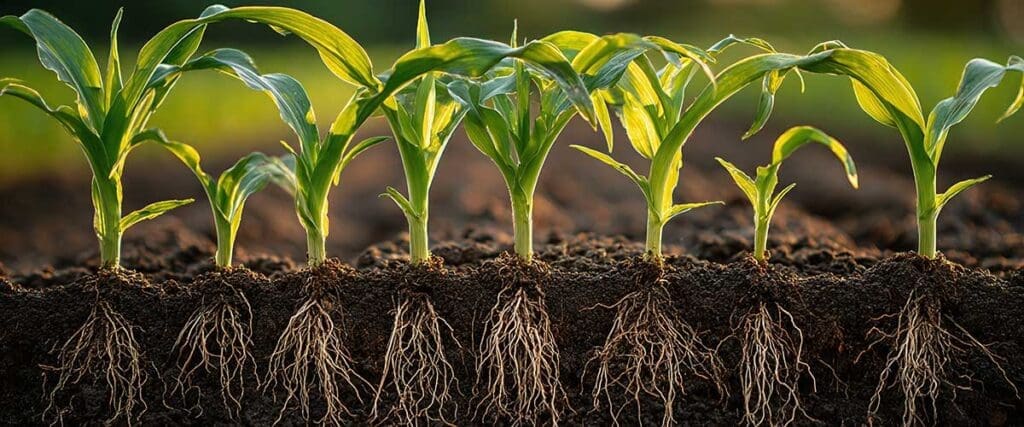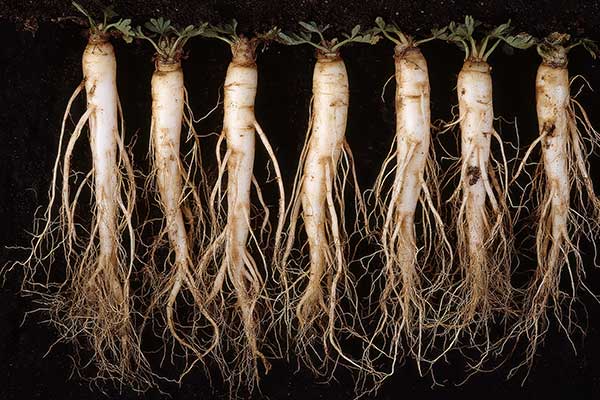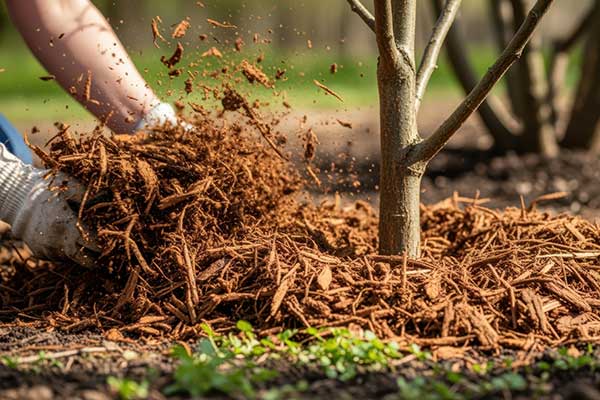
Brisbane’s subtropical climate often meets gardeners with heavy clay soil, poor drainage, and compacted ground. But with the right amendments, plant systems, and techniques, you can transform even the toughest block into fertile, thriving gardens. This guide covers both soil amendments and plant-based strategies to enhance soil quality in Brisbane’s unique conditions.
Key Concepts: Soil amendment, claybusting, vermiculite, dolomite, cover crops, soil health, heavy clay soil, radish, chicory, sunflowers.
Table of Contents
Understanding Clay Soil Problems in Brisbane, Australia
Clay soil is rich in minerals but notoriously difficult to garden in Brisbane because it:
- Holds water when wet → poor drainage and waterlogging, which causes root rot and fungal problems.
- Becomes hard and compact when dry → roots struggle to penetrate and plants can become stunted.
- Often has high pH (alkaline) conditions above optimal for many plants, leading to “lock-up” of nutrients and chlorosis (pale leaves).
- Responds slowly to temperature changes — cold in winter, slow to warm in spring, which delays germination and growth.
One quick test you can try: dig a small hole and fill it with water. If it drains in 1-2 hours, you may get by; if it takes 3-4 hours, it’s a sign you should consider raised beds or heavy amendment before planting. Especially important for root crops and fruit trees, which suffer most from standing water around root balls.
Best Amendments: Vermiculite, Dolomite & More
Improving clay soil in Brisbane often starts with selecting the right soil amendments. Here are some of the best and how to use them:
- Organic Matter / Compost / Aged Manure: The backbone of clay soil improvement. Adds structure, boosts microbial activity, helps buffer pH. Use compost, well-rotted manure, leaf mould. Spread 3-5 cm thick, till or mulch in annually.
- Vermiculite: Enhances water retention & aeration especially for seed starting, containers, and top layers of soil. Vermiculite helps clay hold moisture without becoming waterlogged. Use 10-20% by volume when mixing potting media or topsoil. Also helpful in seed-starter trays in Brisbane’s warm, often drying climate.
- Dolomite (Dolomitic Lime): Supplies both calcium and magnesium, helps balance pH in clay that’s too alkaline or slightly acidic. Only apply after soil testing; use modest amounts to avoid overshoot. In Brisbane, some clay soils benefit from small dolomite applications in spring to improve nutrient uptake.
- Gypsum: Improves structure by helping clay particles to flocculate (aggregate), improving drainage. Good when used with organic matter.
- Sand / Grit: Use coarse sand or fine crushed rock in moderation to increase drainage, but avoid using so much sand that the soil behaves like concrete. Best mixed deeply and alongside organic matter and vermiculite.

Clay-Busting Plants & Cover Crops
Clay-busting plants are essential for Brisbane gardeners. Deep roots naturally aerate compacted clay, improve structure, and leave behind organic matter. Here are the best options:
Radish
Radish is a powerhouse for clay soils. Its taproot penetrates 0.5–1 meter, breaking dense soil layers. After harvesting, leave some roots to decay, forming channels that help air and water penetrate deeply. Radish residues also feed soil life, creating healthier conditions for future crops.
Chicory, Mustard & Cowpea
These fast-growing cover crops have strong roots and nitrogen-fixing abilities. Mustard offers biofumigation properties that suppress soil pathogens. Chicory and cowpea add organic matter, loosen soil, and improve fertility. Plant in rotation with vegetables to continuously improve clay soil health.
Sunflower
Tall sunflowers drive their taproots deep into clay layers, creating natural drainage channels. These roots leave space for smaller plants to establish and enhance subsoil aeration. When cut down, the biomass adds nutrients and organic matter to the topsoil.
Perennials: Alfalfa, Yarrow, Comfrey
Perennial deep-rooted plants gradually loosen soil structure over multiple seasons. Ideal for borders, orchards, or under fruit trees, they also support beneficial insect habitats and soil microbial life.
Clay-busting plants are self-sufficient workers — over the season, they reduce compaction, cycle nutrients, and prepare the soil for your main crops without heavy mechanical intervention.

Planting Techniques for Brisbane’s Heavy Clay Soil
Even with amendments, how you plant makes a big difference. These techniques help roots establish and avoid waterlogging or root suffocation:
- Raised beds: Build beds 20–30 cm high with amended soil; improves drainage and gives root zones more usable soil volume.
- Wide planting holes: Dig holes 2–3× root ball diameter, sloping the sides so roots can grow into native soil; fill with amended soil to buffer clay-soil contact.
- Mulch heavily: Use straw, sugarcane mulch, or coarse bark to prevent crusting, reduce evaporation, and protect the soil surface.
- Fertility trenches: Around trees or heavy feeders, dig a trench around the root zone, add organic soil conditioner, compost, and slow-release fertiliser; cover the trench with mulch to slow wash-off and evaporation.
- Placement considerations: Plant fruit trees or sensitive plants on slightly raised ground or slopes where water sheds; avoid low spots prone to pooling water.
With these techniques, clay soil becomes manageable and plants thrive without root suffocation or waterlogging.
Soil Fertility & Maintenance Over Time
Clay improvement is cumulative. Maintain fertility by:
- Rotating cover crops — legumes, mustard, sunflower, chicory — to disrupt pest cycles and improve soil biology.
- Minimal tilling — deep tilling can destroy structure; use broadforks or shallow cultivation instead.
- Annual compost or aged manure topdressing — worms integrate this into clay over time.
- Slow-release organic fertilisers and trace minerals — iron chelates, magnesium, and micronutrients applied via foliar sprays if clay locks nutrients in.
Over multiple seasons, clay becomes lighter, drains better, and supports stronger plant growth.
Essential Tools & Practices
- Broadfork or U-fork: Loosens compacted clay without flipping layers, preserving soil microbes.
- Digging fork: Slakes planting holes and allows roots to escape into clay.
- Mulching / garden rake: Mix amendments and spread mulch efficiently.
- Soil test kit: Guides amendment application — pH, nutrients, and soil texture.
- Wheelbarrow, sturdy shovel & spade: Heavy clay requires durable tools for comfort and efficiency.
Good tools combined with careful technique — avoid walking on wet clay, use board paths — significantly reduce compaction.

Frequently Asked Questions
- How much vermiculite should I use? 10–20% by volume in topsoil or potting mix; adjust for seed trays or large garden beds.
- Will dolomite raise my soil pH too much? Only if used without a soil test. Use modest amounts and retest soil after a few months.
- Should I replace all clay soil? Not necessary. Improving in stages with amendments and clay-busting plants is more sustainable.
- How long before seeing improvements? Initial benefits in 1–2 seasons; major transformation can take several years of consistent practice.
- Which plants tolerate clay? Natives like Lomandra, Callistemon, groundcovers, and some vegetables planted with buffer soil or raised beds.
Conclusion & Action Plan
Clay soil in Brisbane doesn’t have to limit your gardening ambitions. Using a combination of amendments (vermiculite, dolomite, compost), clay-busting plants (radish, chicory, mustard, sunflower), proper planting techniques, and essential tools, you can transform dense clay into productive, nutrient
Your First 3 Steps
- Carry out a water-drainage test on a small plot (dig a hole, fill with water, time drainage).
- Amend a zone (raised bed or border) with compost, vermiculite, and some gypsum/dolomite. Plant a clay-busting cover crop there this season.
- Implement heavy mulching and minimal walking on that zone; maintain fertility via compost and rotate cover crops annually.
Click here to shop our extensive cover-crop range for clay-busting!
Click here for soil amendments, tools, and clay improvement products for your Brisbane garden!
